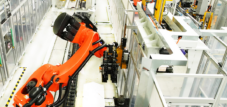Bosch in a two-front war: The fight against 22,000 job losses and the acute production stoppage due to short-time work
Xpert pre-release
Language selection 📢
Published on: October 28, 2025 / Updated on: October 28, 2025 – Author: Konrad Wolfenstein

Bosch in a two-front war: The fight against 22,000 job losses and the acute production stoppage due to short-time work – Creative image: Xpert.Digital
The Bosch case: Is this the end of the German industrial miracle? A company on the brink of collapse is dragging an entire nation down with it.
Bosch earthquake: Why the German giant is now cutting 22,000 jobs – and this could just be the beginning
The German flagship company Bosch, once an unshakable symbol of engineering excellence and stability, is in the grip of an unprecedented double crisis. A perfect storm of long-term strategic failures in the transformation to electromobility and an acute geopolitical shock has plunged the company into one of its most difficult phases ever. The announcement to cut a total of 22,000 jobs in Germany by 2030 is only the most visible consequence of a deep-seated problem that extends far beyond Bosch. While profits collapse and the future of the combustion engine division dwindles, a new chip crisis surrounding manufacturer Nexperia is ruthlessly exposing the fatal dependence of German industry on global supply chains and political power games between the US and China. The crisis at Bosch is thus more than just the story of a company in distress – it is a warning signal for the future viability of the entire German industrial model and raises the question of whether the prosperity built up over decades is at stake.
Suitable for:
- The chip shock: When a component paralyzes Europe's industry – Europe's semiconductor industry at a crossroads
Bosch in the stranglehold of transformation: When the German flagship company becomes a hostage to geopolitical power games
Current developments at Bosch reveal a complex mix of long-term structural deficits and short-term geopolitical shocks, creating a perfect storm. The world's largest automotive supplier is navigating one of the most difficult phases in its corporate history, while at the same time, a new chip crisis is ruthlessly exposing the vulnerability of globally networked production chains. The dimensions of this development extend far beyond the individual company and raise fundamental questions about the future viability of the German industrial model.
At the end of September 2025, Bosch announced that it would cut a further 13,000 jobs in Germany by 2030, in addition to the 9,000 jobs already announced in 2024. This puts a total of approximately 22,000 jobs at risk, a historic dimension unprecedented in the company's more than 130-year history. Particularly affected are the Stuttgart-Feuerbach sites with around 3,500 jobs, Schwieberdingen with 1,750, Bühl with 1,550, and Homburg in Saarland with 1,250 jobs. At the Waiblingen site, all production of connection technology, which employs 560 people, is to be discontinued by the end of 2028. The measures aim to reduce the Mobility division's annual costs by 2.5 billion euros and increase the operating margin from the current meager 3.5 percent to the targeted seven percent.
The management team, led by HR Director Stefan Grosch and Mobility Board Member Markus Heyn, is citing the changing market situation in the automotive industry as the reason. Demand for components for combustion engines is continuously declining, while the hoped-for ramp-up of electromobility is progressing significantly slower than originally anticipated. This is particularly evident in the employment figures. While the production of diesel injection components requires ten employees and gasoline injection systems three, electromobility requires just one. This productivity gap highlights the fundamental challenge of structural change. At the same time, high upfront expenditures for new technologies such as electromobility, hydrogen, and automated driving are placing a massive strain on earnings without achieving the desired market success.
In the 2024 fiscal year, Bosch's sales fell by one percent to 90.5 billion euros, while earnings before interest and taxes plummeted from 4.8 billion euros to just 3.2 billion euros. The operating margin of 3.5 percent is thus far below the requirements of a competitive supplier industry. In the Mobility sector, which accounts for more than 60 percent of group sales at 55.9 billion euros, sales stagnated at the previous year's level. While the equity ratio of 44.3 percent is still solid, the group's ability to invest is dwindling. For 2025, Bosch expects only organic sales growth of between one and three percent, with the operating return on sales expected to improve but still be well below the target of seven percent.
Suitable for:
The structural margin crisis of the European supplier industry
The problem at Bosch fits seamlessly into the picture of an entire industry under massive pressure to deliver results. According to the global automotive supplier study by Roland Berger and Lazard, the industry's average operating margin fell to just 4.7 percent in 2024, after temporarily stabilizing at 5.3 percent in 2023. Before the COVID pandemic, margins were still around 6.7 percent. European suppliers performed particularly poorly at just 3.6 percent, South Korean suppliers brought up the rear at 3.4 percent, while Chinese competitors were significantly more profitable at 5.7 percent.
This development is structural in nature and not merely cyclical. Suppliers are experiencing what industry experts call a phase of stagnation. On the one hand, production volumes are stagnating, while on the other, companies must fundamentally transform their business models. The costs of this transformation are immense, while revenues are dwindling. More than 40 percent of the 25 largest automotive suppliers worldwide now have a non-investment grade rating, which makes it difficult for them to access affordable financing. By comparison, in other industrial sectors such as medical technology, this figure is less than five percent.
Stagformation describes a situation in the automotive supply industry in which production volumes stagnate while, at the same time, major changes resulting from transformation, such as electromobility or digitalization, must be managed. The term is a portmanteau of "stagnation" and "transformation": Growth is lacking, but companies are nevertheless forced to invest heavily in new technologies, which puts significant pressure on margins and competitiveness.
The causes of this margin erosion are complex. Stagnant or even declining vehicle production in Europe and North America is colliding with overcapacity in the supplier industry. At the same time, massive investments in electrification, software integration, and new production technologies must be managed, while automakers, due to their own strained earnings situation, are continuously increasing pricing pressure on suppliers. Added to this are rising energy and raw material prices, higher labor costs in Europe, and increasing demands from ESG regulations and cybersecurity.
The situation is particularly dramatic for specialized suppliers in the field of conventional drive technology. While components for combustion engines will decline by 30 to 35 percent in the coming years, new competencies must be developed in areas such as battery technology, power electronics, and software development. This transformation requires not only capital but also know-how that many traditional suppliers lack. The President of the Association of European Automotive Suppliers emphasizes that two-thirds of members only achieve a margin of less than five percent, and a quarter are even operating at a loss. This means there is no money to finance the necessary investments for the transformation.
The chip shortage as a catalytic shock
In October 2025, a new chip crisis erupted into this already tense situation, brutally exposing the automotive industry's vulnerability to geopolitical upheavals. At the center of this crisis is the Dutch semiconductor manufacturer Nexperia, which belongs to the Chinese Wingtech Group and is one of the world's largest suppliers of simple semiconductors such as diodes, transistors, and battery management chips. The company produces approximately 100 billion semiconductors annually, which can be found in virtually every technical device, from window regulators and engine control units to LED systems in vehicles.
At the end of September 2025, the Dutch government took control of Nexperia, arguing that it had identified serious deficiencies in its corporate governance that would jeopardize the economic security of the Netherlands and Europe. This was due to pressure from the United States, which had placed Wingtech on its sanctions list in December 2024 because the company allegedly continued to supply chips for weapons construction to Russia after 2022. The Dutch government wanted to prevent technological knowledge from migrating to China and prevent the supply of these critical components from being compromised in the event of an emergency.
The reaction from Beijing was prompt and harsh. The Chinese government imposed an export ban on Nexperia products that were to be further processed in China. This hit the European automotive industry hard because, although the wafers are manufactured in the Netherlands, Germany, and Great Britain, the cutting into individual chips, as well as their final assembly and packaging, takes place in Chinese factories. This final production step is particularly labor-intensive and was deliberately relocated to China, where labor costs are lower. Following the acquisition by Wingtech, Nexperia increased its Chinese packaging capacity by approximately 50 percent.
This posed an existential threat to the German automotive industry. Nexperia chips are certified for specific control units; alternative products would first have to undergo complex certification processes and be tested for quality and durability. This process takes months, during which production cannot be maintained. At Bosch, the shortage had a particularly rapid impact on the Salzgitter site, where more than 1,000 employees work in the just-in-time production of engine control units. The plant also coordinates all control unit production within the Bosch Group. According to IG Metall board member and Bosch works council member Mario Gutmann, short-time work has been applied for for these employees, although it was still unclear whether the employment agency would approve the application.
The Bavarian district manager of IG Metall, Horst Ott, reported that other automotive suppliers are also facing severe difficulties in certain areas and have already applied for short-time work. Starting next week, larger suppliers and every vehicle manufacturer are expected to be able to report how the supply bottleneck is affecting them. By then, all crisis scenarios must be ramped up, and then it will become clear whether emergency plans are effective or not. IG Metall's phones were ringing off the hook, and works councils were consulting on the necessary company agreements for short-time work.
Volkswagen announced that vehicle production at German locations was secured until October 30, 2025, but short-term impacts on the Volkswagen Group's production network could not be ruled out. The group was examining alternative procurement options. Christian Vollmer, Member of the Board of Management for Production of the VW Brands, stated that the company had an alternative supplier that could compensate for the loss of Nexperia semiconductors. The question, however, was how quickly this replacement would be available in sufficient volume.
The macroeconomic dimensions of the double crisis
The effects of the combined structural and acute chip crisis extend far beyond individual companies and affect the entire German economy. The Association of Research-Based Pharmaceutical Companies (VFZ) calculated three scenarios in an analysis of the potential impact of a prolonged chip shortage on the German economy. In the best-case scenario, gross domestic product would be 0.04 percentage points lower; in the worst case, by 0.48 percentage points. This would correspond to a loss of up to 21 billion euros in economic output. The German government expects only minimal growth of 0.2 percent for 2025. Should the worst-case scenario materialize, Germany would shrink for the third year in a row, a historically unprecedented development in the history of the Federal Republic.
The calculation is based on the assumption that the automotive and supplier industry will no longer receive semiconductors from the Chinese manufacturer Nexperia. In the first scenario, the economists assume that the production lines for about half of VW's production will be shut down for two weeks, which corresponds to a stoppage of one-fifth of total German car production. By November, production would then be back at 95 percent of pre-crisis levels, and by December at 100 percent. In this case, GDP growth would be dampened by 0.04 percentage points. In the middle scenario, the production stoppage would last four weeks, resulting in a growth loss of 0.15 percentage points. In the worst-case scenario, production would be shut down for eight weeks, which would burden GDP by 0.48 percentage points.
What's particularly problematic is that the impact extends beyond the directly affected companies. If car manufacturers can't produce, they won't order intermediate products. The crisis then also impacts suppliers who, for their part, aren't dependent on chips, such as manufacturers of sheet metal, axles, or tires. In normal times, the automotive industry accounts for almost a tenth of the output of domestic metal producers. The share is even higher, at eleven percent, for plastics producers. A production interruption in the automotive industry lasting several weeks would thus trigger chain reactions throughout German industry.
The long-term structural impact on the labor market is already severe. According to the German Association of the Automotive Industry (VDA), almost 55,000 jobs have been cut in the German automotive industry over the past two years. Employment thus fell by seven percent to 718,200 employees. The decline was particularly sharp among automotive suppliers, at 11.5 percent to 236,700. A study by EY shows that approximately 19,000 jobs will be lost in the German automotive industry in 2024 alone. At the end of 2024, just over 761,000 people were still employed in the sector, the lowest level since 2013.
The job cuts are concentrated among suppliers. In addition to Bosch, ZF Friedrichshafen also announced the elimination of up to 14,000 jobs in Germany by 2028. Continental plans to eliminate another 3,000 jobs worldwide in the automotive sector, and Schaeffler plans to cut 2,800 jobs. In Baden-Württemberg, the heartland of the German automotive industry, a structural study commissioned by the state estimates that up to 66,000 jobs in the automotive sector could be lost by 2030. The question is no longer whether there will be massive job losses, but rather at what pace and to what extent.
The anatomy of an industrial dead end
The current situation reveals fundamental strategic errors on several levels. First, the German automotive industry delayed the transformation to electromobility for too long and then implemented it too abruptly. While Chinese manufacturers systematically built up expertise in battery technology, power electronics, and software development over the years, German manufacturers and suppliers focused on optimizing existing combustion engine technology. When the politically enforced change came, both the technological know-how and the industrial capacity to catch up were lacking. Bosch, for example, withdrew from its battery technology joint venture with Johnson Controls, while the Americans developed it into the now successful company Clarios.
Second, the European regulatory model proved counterproductive. While policymakers operated with increasingly strict CO2 targets and de facto bans on combustion engines, accompanying measures to promote industrial transformation were lacking. Energy costs in Germany are significantly higher than in the USA or China, bureaucratic hurdles hinder investment, and the charging infrastructure for electric vehicles was expanded too slowly. The result is a crisis of confidence among consumers, which is reflected in weak sales figures for electric vehicles. The hoped-for market ramp-up of electromobility failed to materialize, while at the same time, production of profitable combustion engine models was scaled back.
Third, the Nexperia crisis demonstrates the questionable nature of a globalization strategy that has shifted critical production steps to geopolitically unstable regions. Semiconductor packaging may be cheaper in China, but dependence on Chinese production capacity makes the European automotive industry vulnerable to blackmail. The Dutch government responded to American pressure, China countered with an export ban, and the ones who suffer are German workers who are being put on short-time work. The just-in-time production philosophy, considered the epitome of industrial efficiency for decades, is proving to be a fatal weakness in times of geopolitical confrontation.
Fourth, automakers have systematically shifted cost pressure onto their suppliers without considering their investment capacity. OEMs are still achieving acceptable margins in some cases, while suppliers are forced to operate with operating margins of 3 to 4 percent. These margins are insufficient to finance the necessary investments in new technologies. More than 40 percent of major suppliers are now classified as non-investment grade, which increases their refinancing costs and further weakens their competitiveness. The wave of consolidation that has already begun will accelerate. Many medium-sized suppliers will not survive the transformation.
Fifth, the fixation on the automobile as a technology carrier has led to the neglect of other business areas. Bosch is now responding to this with strategic portfolio decisions. The company has acquired Johnson Controls' air conditioning and household appliances business for eight billion euros, the largest acquisition in its company history. The message is clear: Bosch wants to move away from cars and instead focus on heat pumps, air conditioning systems, and building technology. These technologies are expected to generate sales of several billion euros by 2030. However, this diversification comes rather late and does not change the fact that the mobility sector continues to account for 60 percent of the company's sales and will not be profitable in the foreseeable future.
🎯🎯🎯 Benefit from Xpert.Digital's extensive, five-fold expertise in a comprehensive service package | BD, R&D, XR, PR & Digital Visibility Optimization

Benefit from Xpert.Digital's extensive, fivefold expertise in a comprehensive service package | R&D, XR, PR & Digital Visibility Optimization - Image: Xpert.Digital
Xpert.Digital has in-depth knowledge of various industries. This allows us to develop tailor-made strategies that are tailored precisely to the requirements and challenges of your specific market segment. By continually analyzing market trends and following industry developments, we can act with foresight and offer innovative solutions. Through the combination of experience and knowledge, we generate added value and give our customers a decisive competitive advantage.
More about it here:
Bosch in Transition — Why Thousands of Jobs Are at Stake
The socio-political upheavals
The dimensions of the crisis extend far beyond economic indicators. In regions such as the greater Stuttgart area, Saarland, and East Frisia, the automotive industry is the dominant employer. The elimination of thousands of jobs will destabilize entire regions. The IG Metall union calls this the largest workforce reduction in Bosch's history and criticizes the company for not only squandering the trust of those who made the company successful, but also leaving behind a social devastation in many regions.
Highly qualified specialists are particularly affected. At the Hildesheim site, a total of 326 positions are scheduled to be eliminated by the end of 2027, and nationwide, 1,500 jobs in the software and automotive electronics sectors are at risk. These employees have often invested years in their training and are now faced with the prospect that their skills are no longer needed. Leon Zeller, a trainee at Bosch in Schwäbisch Gmünd, wonders if he will soon be jobless. He and his family are deeply worried about the future. The mood has reached rock bottom.
The reactions of employee representatives are correspondingly vehement. The chairman of the general works council of the Mobility division, Frank Sell, firmly rejects a workforce reduction of this historic magnitude without simultaneous commitments to secure the locations in Germany. Instead of negotiating future plans at the locations as agreed, thousands more people are now being asked to leave the company. IG Metall is demanding a further ban on compulsory redundancies. Such a ban on redundancies applies to the division until the end of 2027. The question remains whether Bosch will pay employees severance payments to encourage them to leave the company.
Management urges haste. Stefan Grosch emphasizes that time pressure is intense and delays would further exacerbate the situation. They urgently need to work on competitiveness in the mobility sector and continue to reduce costs permanently. Unfortunately, this will also require further job cuts beyond the previously communicated level. This is very painful, but there is no way around it. This argument is met with resistance from employees, who rightly point out that they are not responsible for the strategic mistakes of the past.
The personnel continuity at the top of the company is remarkable. Despite the massive job cuts, CEO Stefan Hartung's contract was extended by five years, until 2031. The former McKinsey manager has been at the helm of the company for almost four years and is now tasked with overseeing the largest restructuring in Bosch's history. While thousands of jobs are being eliminated, the leadership is backing itself. The message to the workforce is devastating. The message is: The responsibility for the misery lies with the employees, not management.
Suitable for:
The geopolitical dimension of industrial dependence
The Nexperia crisis is a prime example of how deeply European industry is being drawn into a conflict between the US and China, a conflict in which it should not be a party. The Netherlands acted under pressure from the US, which had placed Wingtech on its sanctions list because the company allegedly supplied chips to Russia. China responded with an export ban, which affects European companies. Neither the Dutch nor the German government has developed an independent position in this conflict, but is merely reacting to instructions from Washington.
The German government announced attempts at mediation and additional measures to address the chip shortage, without being specific. Foreign Minister Johann Wadephul of the CDU planned to discuss cooperation between the two countries during a visit to China, but the trip was unexpectedly canceled. The Foreign Office did not provide any specific reasons. The political response appears helpless and lacking in concept. While production is at a standstill and thousands of workers are being placed on short-time work, a strategic response to the challenge is lacking.
The situation highlights the fundamental problems of an industrial policy that has shifted critical production capacities to geopolitically unstable regions. The discussion about supply chain resilience has been ongoing since the COVID pandemic, but concrete measures have failed to materialize. On the contrary: dependence on China has deepened in many areas. Nexperia is just one example. Europe is even more dependent on Chinese supplies of rare earths, battery raw materials, and many other critical materials. Each of these dependencies can be used as leverage in a geopolitical conflict.
The reactions from China on Thursday, October 24, 2025, gave cause for cautious optimism. According to insiders, Nexperia's Chinese subsidiary was allowed to resume deliveries to customers in the People's Republic. However, the condition imposed by the authorities there was that transactions would be conducted exclusively in yuan instead of the previous US dollar. This was apparently intended to make the Chinese subsidiary more independent from the Dutch parent company. Nexperia declined to comment on this matter, but warned of possible quality problems with products from the Chinese factory. The question of whether and when deliveries to European customers would resume remained open for the time being.
The Dutch company is currently looking for alternative locations for packaging and testing its semiconductors produced outside of China. A Nexperia spokesperson emphasized that the company has been pursuing these plans for some time and that they are unrelated to the current dispute. However, this statement lacks credibility. In fact, the conflict demonstrates the need to bring critical production steps back to Europe. Advanced packaging, in which multiple chips are combined or stacked on top of one another, requires higher technological standards and is largely automated. Experts see this as an opportunity to build corresponding manufacturing capacities in Europe. However, this requires massive investments and takes years.
The Chinese challenge as a structural problem
Behind the acute chip crisis lies the fundamental challenge that China has caught up with or even overtaken China technologically in many areas of the automotive industry. In the world's largest automotive market, half of new cars are already electric, and German manufacturers are struggling there. The market share of electrified vehicles is steadily increasing globally, while the share of combustion-engine vehicles is declining. Chinese manufacturers like BYD have firmly established themselves among the world's top-selling manufacturers and are demonstrating not only their growth but also their profitability.
For years, German automakers and suppliers made the mistake of underestimating Chinese competition. They assumed that the technological superiority of German engineering would be sufficient to defend market leadership. This assumption has proven fundamentally wrong. Chinese manufacturers not only produce more cost-effectively, they are now also technologically equal or superior, particularly in the future-oriented fields of battery technology, software, and autonomous driving. BYD increased its sales by over 500,000 vehicles in the first half of 2025 and boasts slightly above-average profit margins.
The European response to this challenge remains half-hearted. Tariffs on Chinese electric vehicles may help gain time in the short term, but they do not solve the underlying problem. German manufacturers must remain competitive in the Chinese market, and this market is increasingly dominated by local suppliers. The strategy of producing electric vehicles in China for the Chinese market is reaching its limits because Chinese competitors operate faster, more flexibly, and more cost-effectively. At the same time, Europe lacks the infrastructure and demand to fully utilize the enormous production capacities that have been built up in recent years.
The situation is particularly problematic among suppliers. Chinese suppliers achieve significantly higher margins of 5.7 percent compared to their European competitors, which only reach 3.6 percent. They benefit from growing demand from domestic OEMs, government incentives, and private investment. European suppliers, on the other hand, are suffering from low production levels, overcapacity, and rising labor costs. They are caught in a dilemma: They must invest in new technologies to remain competitive, but cannot finance these investments because their margins are too low. Many will not be able to manage this balancing act.
The future scenarios and their implications
The question is not whether the German automotive supply industry will shrink, but rather at what pace and with what consequences. Several scenarios are conceivable, each with different implications for the economy and society.
In the most optimistic scenario, German suppliers will be able to focus on profitable niches and develop new business areas through innovation. Bosch, for example, is focusing on by-wire technologies, which replace mechanical connections with electronic controls. This technology is expected to generate sales of more than seven billion euros by 2032. Bosch also sees considerable growth potential in heat pumps and air conditioning technology. If this diversification succeeds, the mobility sector could decline in importance without the overall company collapsing. Employment would decline, but in a controlled manner and without social disruption.
In the medium scenario, job cuts will continue, but will be spread over a longer period and will be implemented in a socially acceptable manner. Redundancies will be avoided, with the focus instead being on severance payments, early retirement, and transfer companies. Demographic trends will help, as many employees will retire in the coming years due to age. The labor supply in the automotive industry will decline by 6.3 percent by 2035 due to age-related fluctuation. However, there is a risk that urgently needed skills will be lost. A disproportionate number of people work in the automotive industry, particularly in occupations such as technical research and development, automotive engineering, and mechanical engineering. The labor supply in these occupations will decline by 2035, while at the same time, electrification will increase their relevance.
In the most pessimistic scenario, the decline of the European automotive supplier industry will accelerate. The combination of structural problems, geopolitical upheavals, and technological disruption will lead to a wave of bankruptcies. Medium-sized suppliers that lack the capital resources or technological know-how for transformation will disappear from the market. Value creation will shift to China and the USA, where government industrial policy and lower energy costs offer better conditions. German sites will be closed, and the remaining production capacity will be concentrated on high-quality niche products. The number of employees in the automotive industry could decline by several hundred thousand by 2035.
Reality will likely lie somewhere between these scenarios, with significant differences between companies. Large, capital-rich corporations like Bosch will survive, albeit significantly downsized and with a different product portfolio. Medium-sized suppliers, on the other hand, will disappear or be acquired in large numbers. Consolidation in the industry is inevitable and already well underway. Distressed M&A, or transactions in special situations, is becoming increasingly important. Such acquisitions offer the opportunity to preserve core operations, secure jobs, and give investors access to technology, personnel, and markets.
Political responsibility and the failure of industrial policy
The current crisis is also the result of years of political failure. The German government failed to develop a coherent industrial strategy for the transformation of the automotive industry in a timely manner. Instead of supporting companies in the necessary restructuring, it imposed a steady stream of new regulations that increased costs without strengthening competitiveness. Energy costs in Germany are among the highest in the developed world, the bureaucratic burden is overwhelming, and approval procedures take years.
At the same time, there was a lack of active support for future technologies. While China invested massive government investments in battery production, charging infrastructure, and the promotion of electric vehicles, Germany relied on the market to sort things out. This naive hope has proven to be a mistake. The US responded with the Inflation Reduction Act, which pumps hundreds of billions of dollars into the green transformation of industry and creates targeted incentives for locating production capacity in the US. Europe, on the other hand, is debating debt rules and stability criteria while its industry is collapsing.
The political response to the current chip crisis is indicative of this failure. Instead of developing an independent position vis-à-vis the US and China, they are allowing themselves to be led by Washington. The Dutch government acted under American pressure without considering the consequences for European industry. The German government announced measures without being specific. The cancellation of the foreign minister's trip to China demonstrates that they are not even capable of keeping diplomatic channels open. This is not industrial policy, but industrial harakiri.
A comprehensive strategy encompassing several elements is needed. First, massive investments in infrastructure are needed, particularly in energy supply and digital connectivity. Electricity prices must be reduced to a competitive level, which is only possible through the massive expansion of renewable energies and the improvement of grid infrastructure. Second, approval procedures must be drastically accelerated. What takes months in China drags on for years in Germany. We cannot afford this waste of time.
Third, we need to actively promote future technologies. Battery production in Europe must be expanded, as must semiconductor manufacturing and advanced packaging. Dependence on China for critical components must be reduced, even if this means higher costs in the short term. In the long term, this investment in supply chain resilience is essential. Fourth, the transformation must be socially acceptable. The employees who have contributed to the success of the German automotive industry for years must not become pawns in geopolitical power games. Training measures, transfer companies, and social security are necessary to facilitate the transition.
Fifth, European coordination is needed. The automotive industry is no longer a national matter. German suppliers supply French and Italian manufacturers, and Czech factories produce for the German market. The value chains are European, and the response to the challenges must be as well. A European industrial program modeled on the Inflation Reduction Act in the United States would be necessary to maintain the competitiveness of European industry. The debate about the debt brake and stability criteria must take a back seat to the goal of preserving the industrial base.
The inevitable reinvention of the German industrial model
The crisis at Bosch is symptomatic of a profound structural crisis in the German industrial model. The past recipe for success, producing high-quality products for the global market, no longer works in a world where Chinese competitors have caught up technologically and operate at significantly lower costs. The notion that German engineering and quality are sufficient to survive in global competition is outdated. The future of German industry lies not in defending the status quo, but in reinvention.
This reinvention requires a rethink at all levels. Companies must be willing to radically question their business models and explore new avenues. Bosch is demonstrating what this can look like with its entry into air conditioning technology and its diversification away from cars. But this transformation must not be carried out on the backs of employees. Employees have contributed to the company's success for decades and deserve respect and social security.
Politicians must finally develop an industrial strategy worthy of the name. This means not only reducing regulations, but also actively investing in infrastructure, education, and research. It means consistently driving forward the energy transition to enable competitive electricity prices. It means reducing dependence on authoritarian regimes for critical raw materials and components. And it means strengthening European cooperation instead of pursuing national unilateral efforts.
Society must prepare for the fact that change will be painful. Entire regions will have to redefine their economic focus. Baden-Württemberg, which proudly calls itself an automotive state, will have to reinvent itself as a healthcare hub, as Minister-President Winfried Kretschmann emphasizes. This transformation requires not only economic adjustments but also a new self-image. The days when every Baden-Württemberg resident could wake up in the middle of the night and immediately know that automotive, mechanical, and plant engineering were the most important industries are coming to an end.
The challenge is immense, but not insurmountable. Germany boasts a highly qualified workforce, excellent research institutions, and a strong industrial base. The innovative power is there, as is the technological know-how. What is lacking is the political will to set the necessary course and the societal willingness to actively shape change rather than passively suffer it. The alternative to a managed transformation is uncontrolled decline. The choice is ours.
Your global marketing and business development partner
☑️ Our business language is English or German
☑️ NEW: Correspondence in your national language!
I would be happy to serve you and my team as a personal advisor.
You can contact me by filling out the contact form or simply call me on +49 89 89 674 804 (Munich) . My email address is: wolfenstein ∂ xpert.digital
I'm looking forward to our joint project.
☑️ SME support in strategy, consulting, planning and implementation
☑️ Creation or realignment of the digital strategy and digitalization
☑️ Expansion and optimization of international sales processes
☑️ Global & Digital B2B trading platforms
☑️ Pioneer Business Development / Marketing / PR / Trade Fairs
Our global industry and economic expertise in business development, sales and marketing

Our global industry and business expertise in business development, sales and marketing - Image: Xpert.Digital
Industry focus: B2B, digitalization (from AI to XR), mechanical engineering, logistics, renewable energies and industry
More about it here:
A topic hub with insights and expertise:
- Knowledge platform on the global and regional economy, innovation and industry-specific trends
- Collection of analyses, impulses and background information from our focus areas
- A place for expertise and information on current developments in business and technology
- Topic hub for companies that want to learn about markets, digitalization and industry innovations

























